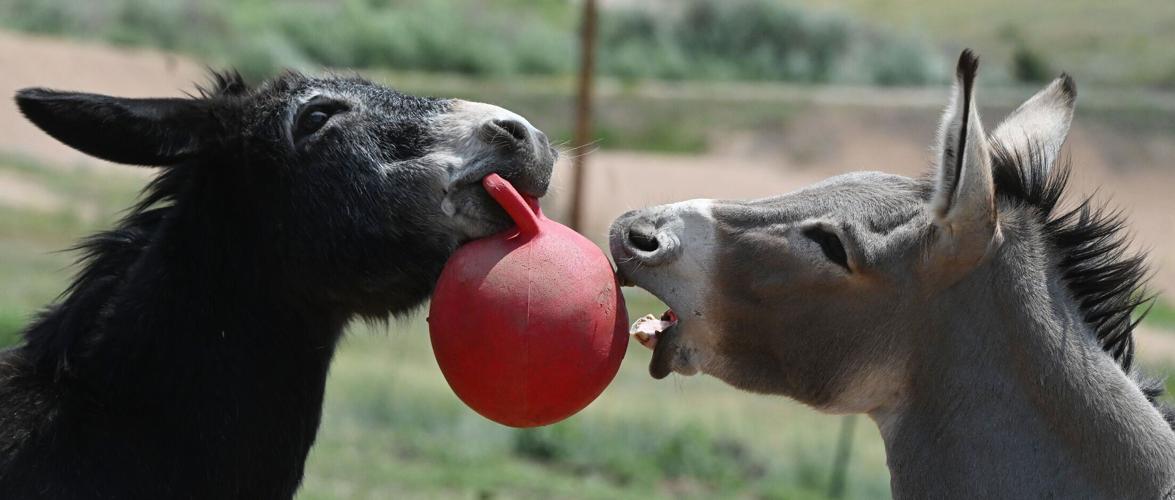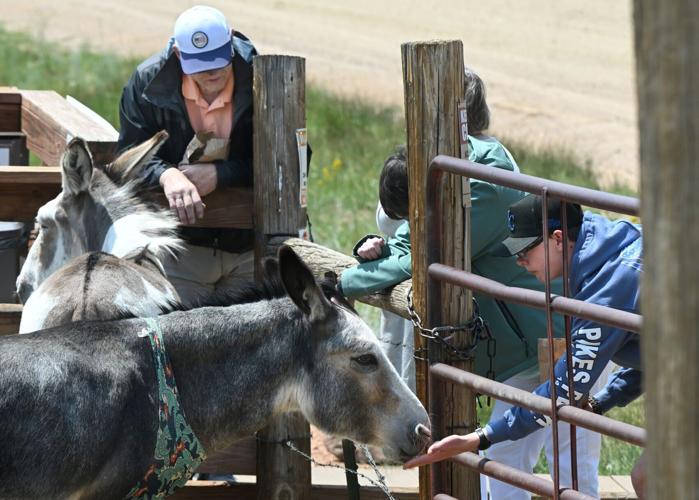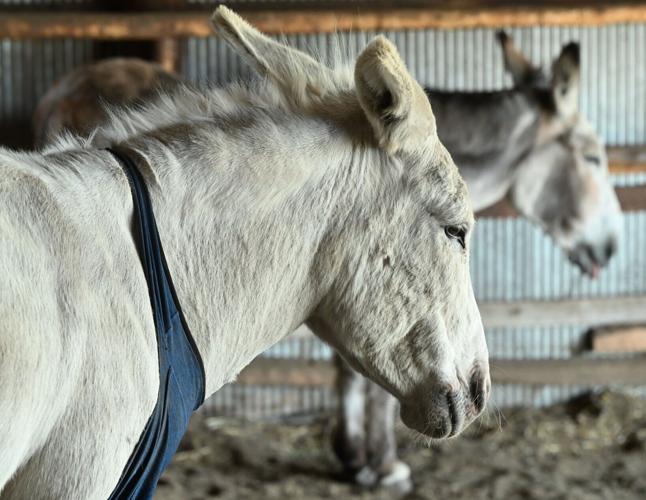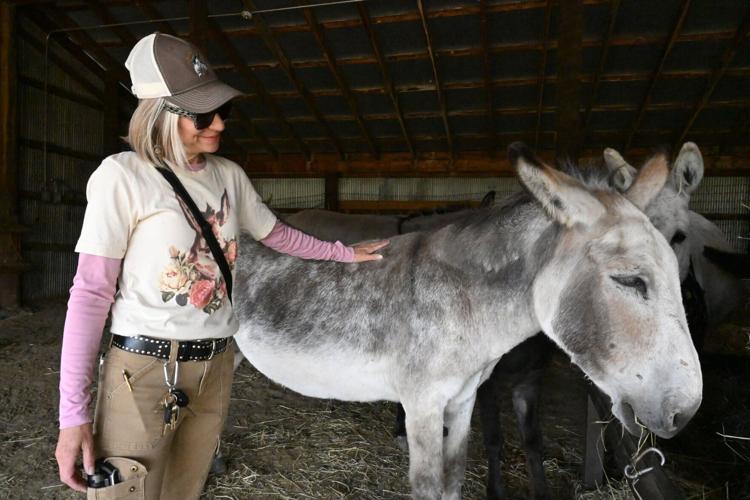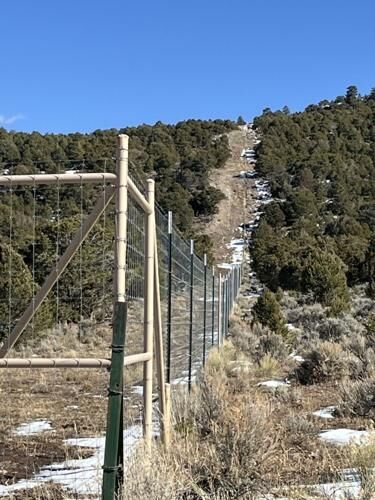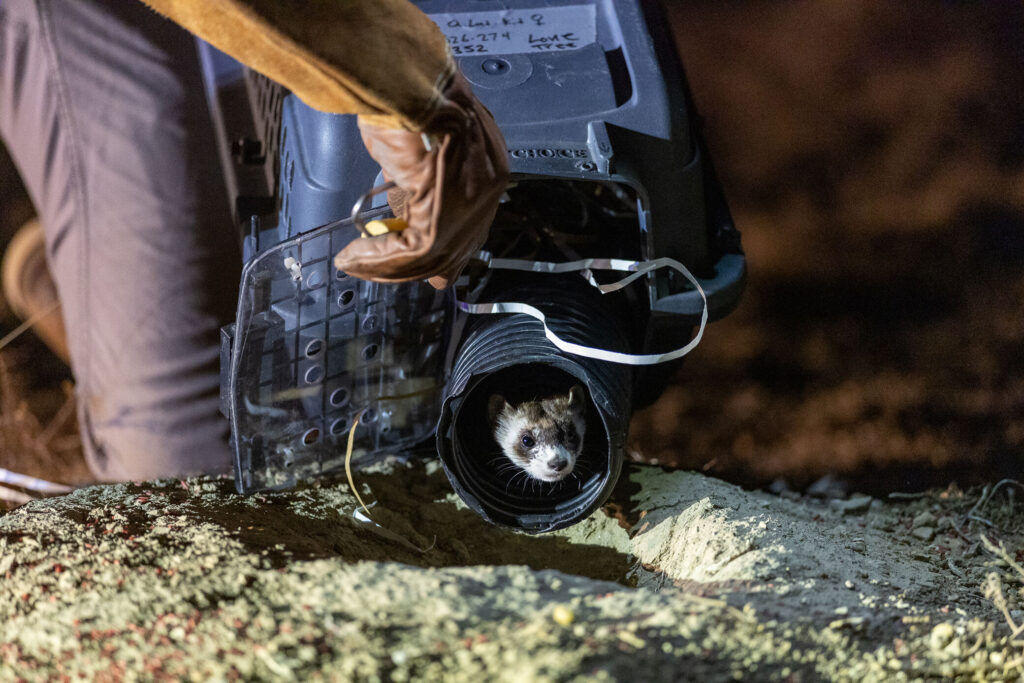Donkeys on a diet: Cripple Creek donkeys work to combat weight gain
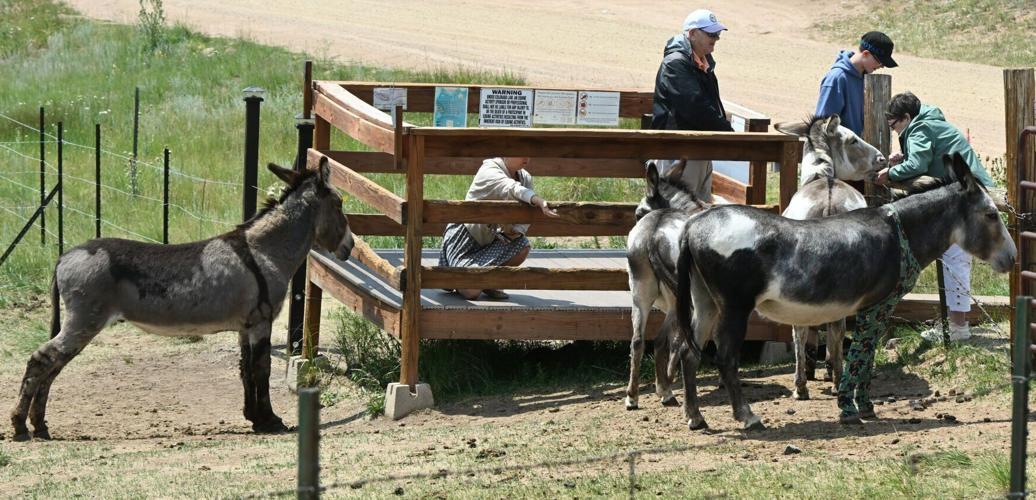
Visitors to Cripple Creek come to the feeding platform to get close to the famous donkeys. The Two Mile High Club, which has cared for the town’s herd since 1931, is working to educate visitors about proper feeding habits in response to the pack’s notable weight gain.
Jerilee Bennett,The Gazette
CRIPPLE CREEK • Just past the donkey stables in Cripple Creek, down a dirt road, there’s a wooden feed stand layered in signs.
“Please NO carrots, NO apples, NO bananas, NO human food” the signs emphasize, with bright images of the foods crossed out by a red ban circle.
Several visitors stop by, waiting to see the critters come out of their shelter to receive pets and treats. In their hands, they carry brown paper bags holding doctor-approved treats — high-protein hay cubes.
There’s a cooler full of them, too, in case you forgot your own. For a small donation ($1 suggested), you can grab a cube to feed the burros.
The sound of the crinkling paper bags sends the donkeys running (or perhaps more accurately, lightly jogging). They trot, some more enthusiastic than others, some waiting for their pal to catch up, to the wooden platform.
There’s no question they’ll take it — there’s even a sign warning you to keep your hands flat or risk losing a finger. But this time, they’ll be munching on something a little healthier.
The Cripple Creek donkeys have gone on a diet. Coined the “Healthy Herd Campaign,” the Two Mile High Club, which has cared for the town’s herd since 1931, is working to educate visitors about proper feeding habits in response to the pack’s notable weight gain.
Walking to the barn, Laura Piccolo, secretary and social media manager for the Two Mile High Club, tells me just how risky obesity is to donkeys. The animals are prone to equine metabolic disorder, she said, a condition similar to Type 2 diabetes in humans.
As animals who originated from arid regions, donkeys’ digestive tracts adapted to move slower to allow for greater nutrient absorption. So, when they receive a constant excess of food, they gain weight quickly.
Piccolo has seen firsthand just how much the donkeys can be overfed in a single day by tourists and locals, including residents who sprinkle corn on their lawn to attract the donkeys.
“I actually stood out in their pasture one time, a Sunday morning, and I collected 80 pounds of carrots in a four-hour period,” Piccolo said. “Even though it’s natural sugar, to understand the quantity that they’re getting, it’s hard to fathom.”
And in the summertime, that’s nearly every day.
The team started looking for solutions last year, near the end of summer, after learning that 10 of the herd’s 14 members had body condition scores higher than normal. These scores, measured using the Henneke body condition scoring system, rate the donkey on a scale between 1 and 9, with the ideal, healthy number being 5, said the herd’s veterinarian Maria Baylor of Rocky Top Veterinary Service.
“You don’t want to be too low on the scale, and you don’t want to be too high on the scale. So she basically takes measurements to figure out what their body condition is, and then feels around, you know, are there fat pads?” Piccolo explained.
Once donkeys have fat pads — and some of them have quite large fat pads, Baylor said — the goal isn’t to make the cushioning disappear, which can be unhealthy, but instead measure their progress over time to ensure they aren’t getting larger. For example, Baylor will assess if the fat pads are growing or shrinking — if they’re firm or soft.
So as last winter approached, the team prepared to monitor the donkeys on a strict diet in hopes of getting them back to a healthy size — and it worked. Most of the donkeys responded well to the controlled diet and managed to get back to a healthy weight.
“They came in heavy in the fall,” Baylor said. “I was very pleased with the progress we made over the winter. I was really happy with that. When we turned them out in the spring, they were looking fairly good.”
That changed, however, following their Memorial Day release. The donkeys have historically roamed the town of Cripple Creek during the summer months, being ceremoniously released on that holiday weekend and brought back in around October for nearly a century, a remnant of the town’s gold mining past.
“When we penned them back up for Donkey Derby Days, because obviously there’s a lot of crowds in town, so for their safety and for the Fourth of July, we brought them back here. The vet came to check on their body for a condition, and noticed that just in that short period of time that they’re starting to gain weight again,” Piccolo said. “So under her guidance, we have brought them back to the pasture.”
And it looks like for this year, at least, the donkeys will stay at the barn along County Road 89.
One of the main concerns if yo-yoing weight, said volunteer caretaker Dale McKenzie, who has worked with the donkeys for about four years and is at the barn daily. He’s passionate about the critters, naming each one as they walk back into the shaded barn from the feed stand and telling me about their personalities. “Everybody loves donkeys,” he said.
“There’s (a) few of them that still are a little heavier, and we’d like to get them down. But if we release them back into town, they will gain weight, and we don’t want to do that yo-yo thing,” said McKenzie, who’s trying to apply some ointment to the herd’s oldest member, Coco, a 43-year-old white donkey with a little cut on his snout.
Two of the donkeys already stay at the barn year-round because of health issues, including the 34-year-old Emma Lou. She has equine metabolic syndrome and insulin resistance, McKenzie said, so he has to give her medication every day.
“Emma, she’s kind of big. She can’t fit into her skinny jeans yet,” McKenzie joked.
So, what’s the solution? Right now, visitors can still meet the donkeys in-pasture at the feed stand. Along with the signage, the Two Mile High Club has provided the high-protein hay cubes as an alternative to sugary produce. Ultimately, it’s about education and balance, Baylor said.
“How can we strike a balance between the tradition and, frankly, the fun of letting these guys out and letting people feed them and all the things people associate with the donkeys, but also maintaining their health, their well-being and their longevity,” Baylor said.
“There’s no perfect answer,” the veterinarian continued. “The metabolisms vary from donkey to donkey. They’re in different ways of their lives. They have different underlying conditions. There’s some donkeys that we worry about more than others. So I think the main driver has been twofold — that the donkey, they’re aging, and we really want to keep them doing well, well into their their old age, right? And I think No. 2 is that (Cripple) Creek is seeing more tourists.”
Those hay cubes are also available at shops around town, including the Cripple Creek Heritage Center, which has a basket filled with the treats, wrapped in brown paper bags.
Michelle Rozell, the Cripple Creek heritage tourism manager, is happy the Two Mile High Club is promoting the Healthy Herd Campaign.
“I’ve seen them be fed popcorn, anything people have in their car,” said Rozell, who was working the front desk of the center. “It really is serious. … Once you explain to them what the situation is, they’re very understanding.”
And even though tossing an apple their way may be done in an act of affection, the best way to take care of the herd is by keeping them healthy.
“It’s a love of the donkeys that keeps us going,” McKenzie said. “Everybody loves donkeys. They’re just fun to be around, and they all have different personalities. … They got excellent memories. So if you treat them bad, they will remember that. Treat them good, they’ll love you.






